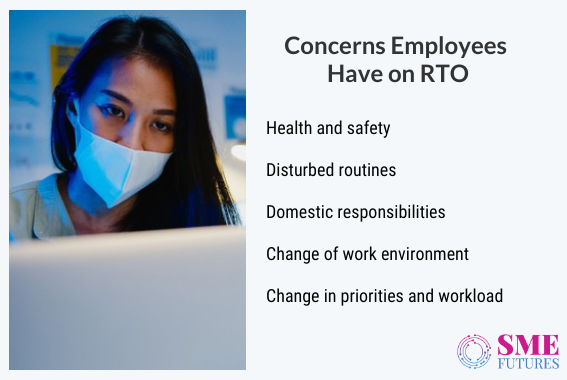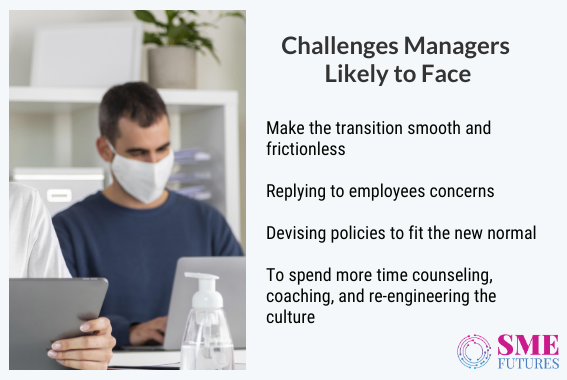For most employees in India remote work has become the new work-life routine. During the course of 2020 they adjusted their lives, routines and schedules to these new work requirements. But now, with the vaccine roll-out and inoculations going on, offices are re-opening.
Return to Offices (RTO) is going to be another major task this year for businesses, after marshalling their resources to deal with the pandemic last year. Pharma, IT, ITeS and the BPO sectors are returning to offices at a faster when compared to pureplay software companies. A survey conducted by Hyderabad Software Enterprises Association (HYSEA), revealed its findings related to RTO. It said, RTO will peak towards the end of 2021 and will never be 100 per cent.
Although it sounds optimistic, the question still remains about when India Inc. will be back to its offices at a 100 per cent.
No one can be specific about the answer to that.
Many Indian businesses are already putting ‘return to office ‘strategies in place while quite a few firms are already back at their offices. There are also many employees who favour a hybrid mode of doing work.
“After analysing the situation and looking at the decreasing case trends of COVID in Delhi we have decided to reopen the office, at least in New Delhi,” says Himanshu Arya, Founder & CEO, Grapes Digital.
He further avers that currently, only 20 per cent of employees have resumed work from the office, while others are still working from home. “The comeback is being implemented in a phased manner. We are planning that another 30 per cent will join the office in March taking the total occupancy to 50 per cent in the following month,” adds Arya.
Arya’s company, taking their cue from a recent Sero-Survey on RTO, have conducted their own in-house survey to understand their employees’ point of view before taking this decision. The survey highlighted that 20 per cent of their employees want to go back to the office from February, while 20-50 per cent prefer March, and the rest have opted for April to go back to the office, he informs us.
Similarly, Whatfix, a Digital Adoption Platform (DAP) that helps enterprises accelerate the adoption of software applications is all set for the “Back to Office” mode and has diligently been taking steps around planning seating arrangements for its employees.
The company’s Global Senior Director-HR, Romita Mukherjee, tells us that her firm has been investing heavily in re-innovating their office spaces. “Changes are being done to align with the new normal work protocols and we will be ready to get our employees back to the office in the next few months. The company aims to operate at the office partially for the initial few months, prioritizing the health and well-being of our employees and their family members. Employees are encouraged to come over to the office for meetings and connect informally with their teams, as Whatfix believes in giving complete flexibility to its employees,” she says.
A major supporter of the hybrid or flexible work culture, Zostel, which is a shared accommodation provider, is mainly focused on the convenience of its employees when it comes to returning to the workplace.
In fact, they have put in place a comprehensive communication infrastructure for their teams using a mix of in-house products built over WhatsApp in addition to third party products like Slack and Notion which has allowed for remote work to be efficient and productive.
Aviral Gupta, HR head and Chief strategy officer at Zostel shares with us, “We will not be enforcing a mandatory return to the workplace and plan to operate according to a hybrid, flexible model allowing our employees to come to the office at their convenience and when needed. Our team is currently spread all across India with 90 per cent of them having chosen to work while travelling”.
Meanwhile there are firms which have already achieved a full-fledged return to the office. Doceree, is one such company.
Telling us about what’s going on in his company, Daleep Manhas, co-founder and MD (India) says, “We have started work at full strength now. We have a bigger office space; hence, social distancing is not compromised at any time. Work from home (WFH) is still available for people with any symptoms of cold, flu and fever and it has become an integral part of our culture. There are a few resources who have opted for WFH, and we allow that too.”

Back to the office but with flexibility
After having spoken to all these people it is quite apparent that a return to the office is definitely on the cards now and it will be in a phased manner. Consequently, this exercise will require heavy planning and investment. Also, businesses now understand the seriousness of the health and wellbeing of their employees and its impact on their work. That is why they are considering making the work culture in their companies more flexible and accommodating based on productivity, fluid timings and a multiplicity of locations. And this super trend has been last year’s gift to us.
According to this model companies retain their headquarters but operate from multiple regional offices or co-working spaces.
Zostel has been following this trend too. HR Head Gupta tells us that they are keen on operating with a hybrid model for the conceivable future. “Over the next 6 months, we expect 40 per cent of the team to start coming to the office while the rest continue to work remotely. There would, however, be no directives to work from the office compulsorily and employees are free to choose what suits them best at what time,” he said.
Grapes Digital is also on the same page. Starting with RTO from their Delhi centres, the company is following all the standard procedures. Arya tells us, “We have not opened our Mumbai office yet, we will come to a conclusion soon based on the response and will follow all the necessary SOPs announced by the state government. So, we are transitioning into a hybrid working model-that comprises work from home and work from the office. In the last few months, we have adapted to this model effectively, so it is not a challenge anymore.”
Co-working spaces which were in a financial limbo last year are expecting a revival which this hybrid working model promises. IWG Plc (formerly Regus) that provides flexible service workspaces, already foresaw this emerging trend. Hence, they kept their centres open throughout the troubled period after the pandemic struck and this has helped them to up their game in the flexible co-working arena. Harsh Lambah, Country Manager India, VP Sales – South Asia at IWG plc while commenting on this, said to us, “We not only kept our offices open throughout the pandemic, but we also ensured that the highest levels of sanitation and hygiene were maintained in order to ensure that all the health and safety norms are met. We continue to work closely with our clients and where relevant, with civic and other authorities, to formulate strategies and approaches on how to operate our offices safely during the pandemic.”
Currently, IWG has 3,500 centres globally and 100 in India and is helping working professionals to find a balance between work-from-home and working at the office.
“Going forward, we will see more and more organisations permanently embrace a hybrid model of working. This hybrid model will allow a convenient blend of operating from or closer to home,” Lambah adds.

RTO means giving employees a free hand
We are slowly but steadily emerging from the impact of the pandemic and If we go by the surveys, many people had already started going to their offices last year.
A Workinsync survey in its early findings stated that the number of people who returned to their offices in November 2020 was 10 per cent higher compared to March 2020. It also found that 77 per cent of Indians found remote work to be dull and 65 per cent of the people were looking forward to RTO. Mumbai and NCR were leading this return to the office trend.
Meanwhile a survey by HYSEA on IT companies in Hyderabad says 60 per cent of the companies plan to have less than 20 per cent of their workforce operating from the office by the end of March 2021. But there will be a significant increase of 40 per cent in work from office (WFO) numbers by the end of June.
Nearly 75 per cent of large and very large companies are planning on only 0-9 per cent of their employees working from the office by the end of March. By June 2021, the WFO percentage is likely to reach 20 per cent and in quite a few cases, WFO is expected to reach 30 per cent. By December 2021, the likely WFO percentage for large and very large companies is 50-70 per cent.
More than 55 per cent of the Industry plans to increase their WFO percentages to greater than 70 per cent by Dec 2021, with more than 39 per cent planning to increase it to greater than 90 per cent.
The survey also found that a significant percentage of employees at large companies were working from their native places. Thus, RTO will become that much more time-consuming and complex considering the reverse migration that will ensue in large numbers. This will compel companies and HR teams to device new strategies for their safe return while not compromising their health.
This has its own pros and cons, including investments, giving more choice to employees, and global hiring.
“It has been a year since we all started working from home and now most of the employees want to go back to their normal routine. We have given multiple options to our people to choose as per their preference,” Arya of Grapes Digital says while expressing his thoughts. He further elaborates, “We conducted a survey. After looking at the response, we are aiming to have a 100 per cent occupancy rate back at our Delhi office starting from April. However, this will be strategised as per the situation. The management has decided to make sure that the mandatory safety norms are adhered to duly in a calibrated manner,”
Will jobs return with RTO?
Then we put forth another question, could RTO pave the way for the return of those jobs that were lost during the lockdown?
Business executives are mostly optimistic. Most of them have observed an uptick in the hiring trend.
“While the job market will undoubtedly pick up as the economy inches towards revival, I believe that lost jobs will be revived in spite of RTO,” says Gupta.
Over the past year, all businesses have had to adapt to remote working and fine-tune their day-to-day operations accordingly, and as such have started to become comfortable with remote management.
According to him, this is now going to throw open a much larger opportunity for companies to scout and hire talent easily from anywhere on the globe, onboard them and get them to work almost effortlessly. “For candidates seeking jobs, this paves the way for them to access companies that might have been out of their reach earlier due to geographical constraints. I believe that the work from office model has seen a progressive change towards a hybrid working model which is here to stay, and it is going to lay the foundation for a better, more accessible job market as we emerge from the ravages of the pandemic,” professes Gupta.

Whatfix’s Mukherjee believes the same. She feels that the new norms have expanded work culture. Talking about her own firm, she tells us that the pandemic has led them to expand their operations, which has resulted in more hiring. In these circumstances, it has also allowed them the option to hire people from a global talent pool.
“Over the past year, we have had over 260 new hires globally, bringing the total number of employees to 430. Currently, we continue to operate in flexible mode with most of the employees working from home. The teams are encouraged to come to the office to host events, team bonding exercises, team huddles and new joiners connects, “she further elaborates.
When asked, Himanshu Arya too said that RTO is giving companies a basis to hire more people, “After working from home and being away from our colleagues and the office, we all need to kickstart 2021 with full energy and enthusiasm. Since October, we have hired many people in various departments because digital has become essential for every company to conduct their business.”
“We are optimistic that this year job demand will increase in multiple sectors as businesses get back on the ground. After witnessing a bounce back in our own business, we are anticipating that Grapes will continue to hire as per the demand and requirement of various departments,” he further adds.
It is all about technology
Getting the teams back to the office is certainly not going to be easy. The challenges are numerous, and the only viable solution is to create a safe environment by utilizing tech solutions. Over the past year, IT operations have helped a lot in connecting the dots about when, where, with whom and how we are going to work. Technology helps with functions such as ensuring employee flexibility, sanitization, space and capacity, workplace scheduling etc.
Industry experts, especially in HR, understand that technology is imperative.
“Tech adoption across the entire breadth of company domains has never been more important. Companies need to move fast to organise their workflows and processes, and at the same time educate and support all employees with tech products that would help them to function as a unit, even remotely,” says Gupta, Zostel’s HR Head.
Sharing his experience while working with technology he further says, “Bringing in transparency and setting up clear KPIs and measurement indicators are beneficial for both the company and its teams as they work remotely. Having adopted these processes and tech products months before the pandemic arrived while simultaneously documenting the usage and applications of each of these, has helped Zostel to continue operating normally without many changes to our daily processes, with most training and usage manuals already in place.”
Whatfix’s HR Head Romita Mukherjee also contributes her viewpoint, “We are aiming at creating a work culture that thrives on innovation and experimentation and strong work collaborations across teams. Towards this, we are considering technologies that can help drive an innovative mindset – innovation labs and ideation tools and collaboration platforms like Slack, Jira, Trello, etc.”
Technology has always been the epicentre of any business, be it a street vendor or an MNC. So, there is no question of surviving without it. “Even the employees have acclimatised themselves to it,” remarks Arya.
He further adds, “We have various kinds of technology tools and that’s how we have rapidly evolved and conducted our business. For instance, when the pandemic began, we created a tech tool using which our employees can get all the information on a single portal instead of asking the HR team. We are very technical and even in the post-covid environment our employees will not require any sort of training or change in the ecosystem.”
Apps like MS Teams, Zoom, Google Meet and others have made working virtually more engaging.
At the same time, there has been a realisation that the traditional set-up of corporate offices where employees congregate daily, and in-person is no longer essential to ensuring employee engagement or boosting productivity.
A lot of engagement is now being driven remotely through the smart use of technology. Surveys have shown that the response to the pandemic has speeded up the adoption of digital technologies by several years and that many of these technologies are now here to stay. This advent of technology has led to the plausible conclusion that greater functionality with less physical engagement or proximity is the new normal.

Play by the rules
Of course, the office environment of 2021 is a rules-based one. Health and hygiene are going to be a priority. Right from meeting rooms, desks, and a food court, everywhere an employee goes, rules should be followed.
“Returning to work in 2021 will be an entirely new experience. Businesses big and small will continue to adapt and evolve, keeping in mind regulatory bodies’ orders and employees’ health requirements. Organisations will concentrate on enhanced sanitization and revamping their seating arrangements to ensure appropriate distance between employees. Many organisations are beginning to follow a roster system, keeping office occupancy at no more than 30 per cent strength whilst the pandemic continues,” says Lambah.
Experts are also of the opinion that it should be a collective approach. Not only the management but the workers also need to understand why these protocols are in place.
Talking about SoPs Arya tells us that his management ensures that stringent protocols are in place for the safety of their employees. They are also looking at a re-distribution of the seating arrangements to maintain safe distances to ensure that safety is not compromised at any level. “Our employees are our strength, and we will do everything possible from our end. Till now, luckily everyone is safe, and the management has decided that once we resume and subsequently any person develops covid symptoms, he/she will be immediately allowed to avail of leave as per their doctor’s recommendation and will be allowed to work from home for at least 15-21 days,” he tells us.
Six feet office
Returning to the office is pushing businesses to re-think their spaces. Office spaces are being re-imagined structurally. We can say that in terms of design and workability it is another opportunity for some sectors and it shows that business management is covering all the aspects regarding RTO.
Lambah, while discussing this with us says, “With people returning to work, the design of the conventional office is suddenly in the spotlight.”
While some element of social distancing is likely to be in effect for some time, businesses will also need to keep in mind and address the gap between their employee’s new health and hygiene expectations and the design of the modern office.
“Distributed workforces will be the new normal and new concepts like ‘the six feet office’ will become increasingly popular. The six feet office includes design tools to keep employees six feet apart from each other, including barriers between desks, pedestrian lanes that keep traffic flowing in an orderly way, and disposable supplies to keep germs from spreading. Large, airy meeting spaces could grow in popularity, while private pods may be appealing for workers, “elaborates Lambah.
Working on the same principle, most of the experts we spoke to have either rented their office premises or are designing their centres, keeping the new norms in mind. For instance, the Whatfix office, which is on a rental agreement, has rented multiple spaces to ensure safety and social distancing among their employee groups. In fact, they are also investing in renovating their spaces to suit their post-Covid seating and workplace guidelines.
WFH to WFO—the transition
If given a chance, most executives would like to have their entire teams back, as per the various surveys.
Let us now talk about employees. How are they reacting and responding to this?
Most of us are now habituated to the work from home mode. At this moment, RTO is not going to be an easy task for any employee. for some it is going to be a nightmare. And there are various concerns regarding that.
The apprehensions about returning to the office are high. When asked about it, Charu Garg who works for a domestic company tells us, “I am working from my native place. First, the concerns are about health. Even if there are SoPs, human nature is to be sceptical about sanitation and adequate social distancing,”
For others it is about disturbed routines. Currently, work minus the commute and dressing up has spoiled the working population. Hence, having to once again get up and get dressed and then travel to work might be upsetting to many who have gotten comfortable with working from home. That also means no more pyjamas.
Domestic responsibilities have now increased concurrently with the changes in our routines. Reverting to the old routine or figuring out other alternatives could take time. Additionally, the workload will also be impacted along with the change in priorities. Low-priority tasks could start taking precedence. HR and workplace managers need to decide on the best working model based on the concerns and job requirements of their employees.











